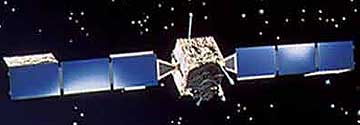
Artistic rendition of the Inmarsat F2 satellite.
...just days short of its 20th birthday. The spacecraft was built by a British Aerospace consortium with a projected operational lifespan of 10 years. The final 'switch-off' command to Inmarsat-2 F4 was sent at 08.08 UTC on April 5th from Inmarsat's satellite control centre in London. The spacecraft now rests safely in a satellite 'graveyard' 660kms (410 miles) above its former location in geosynchronous orbit.
Since its launch in April 1992, F4 has supported a range of key services, including our pioneering Inmarsat A system and its digital successor. However, last year, the satellite developed a problem with one of its two solar arrays and services were transferred to another Inmarsat satellite so decommissioning could begin.
The spacecraft is outlived by its sisters, the Inmarsat-2 F1 and F2, which are both more than 21 years old, a testament to the engineering expertise invested in the our first wholly owned constellation.
"The longevity of the Inmarsat-2 satellites is a tribute to the technical effort and expertise of the original Inmarsat and British Aerospace designers, as well as the operations teams who have managed F4 during its lifetime," said Inmarsat chief executive Rupert Pearce. "This tradition of excellence continues with our current Inmarsat-4 satellites, which are expected to continue well into the 2020s, and also our fully-funded, next-generation Inmarsat-5 satellites planned for launch in 2013-14 and Alphasat expected in 2013."

